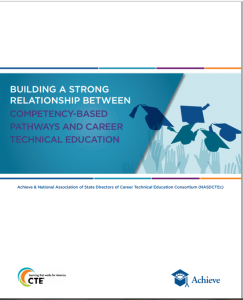Long after the tassels are turned, the podiums are packed away, and the diplomas framed and positioned on the wall, state policymakers are hard at work devising new policies to help the next class of high school students graduate career ready. Whether through career readiness expectations, Career Technical Education (CTE) graduation endorsements or alternative CTE graduation pathways, helping learners build the skills they need to be successful in their future careers is a priority for policymakers in Illinois, Missouri and Pennsylvania.
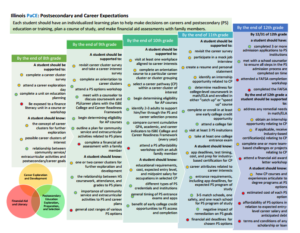
In Illinois, a new Postsecondary and Career Expectations (PaCE) framework comes on the heels of 2016’s Postsecondary and Workforce Readiness Act. That legislation, designed to enhance the Illinois education system to better prepare learners for college and the workforce, adopted a number of strategies including a competency-based learning pilot, college and career pathway endorsements, and supports for educators and district leaders. Specifically, the law directed the Illinois State Board of Education and other state agencies to identify expectations for students between grades 8 through 12 to be prepared for success after high school. Under the law, these expectations would need to focus on career exploration and development; postsecondary institution exploration, preparation and selection; and financial aid and financial literacy.
Earlier this month, the Illinois State Board of Education formally released the newly-developed PaCE framework, outlining guidelines for college- and career-focused activities at each grade level. Many expectations are aligned to a student’s self-identified career pathway. By the end of 10th grade, for example, students are expected to participate in a mock interview, create a sample resume, and identify an internship opportunity related to their career pathway. However, career exploration is emphasized in earlier grades through Career ClusterⓇ interest surveys and career exploration days. Though use of the framework is voluntary, it is designed to empower local educators and administrators to better target supports to students to ensure they are on track for success after graduation.
Missouri’s New CTE Diploma Endorsement Celebrates Student Achievement
Meanwhile, the Missouri State Board of Education outlined requirements for the state’s new CTE graduation certificate. The certificate program, authorized under 2016’s SB620, is designed to recognize the value add that CTE provides, helping equip students with the technical and employability skills to be more competitive in both college and the workforce. The legislature specifically called on the State Board of Education to work with local school districts to ensure the certificate program does not incentivize tracking, or “separating pupils by academic ability into groups for all subjects or certain classes and curriculum.” Rather, the legislation emphasizes program quality, encouraging local school districts to rely on industry-recognized standards, skills assessments and certificates.
In June, the Missouri State Board of Education finalized requirements for a CTE diploma to recognize students who, in addition to completing their core graduation requirements, focus in a CTE area of study. True to the intent of the law, the requirements above all emphasize achievement. Students are only eligible to receive a CTE endorsement if they, among other requirements, maintain a 3.0 GPA in their CTE concentration, earn an industry-recognized credential or a passing score on a technical skills assessment, complete at least 50 hours of work-based learning, and maintain an attendance record of at least 95 percent throughout high school. By prioritizing student success and achievement, Missouri’s CTE diploma requirements appropriately recognize that CTE enhances the traditional high school experience.
Alternative Assessments for CTE Concentrators in Pennsylvania
Finally, CTE students in Pennsylvania will have more flexible pathways to graduation after lawmakers amended a yet-to-be-implemented examination requirement. The change comes in response to a 2014 State Board of Education rule that required students to pass Keystone examinations in Algebra I, Biology and Literature before graduating. Although the requirement was scheduled to apply statewide for the graduating class of 2017, the legislature last year decided to delay implementation to give the Department of Education enough time to identify alternative assessment opportunities for CTE students.
Under the original policy, students who failed to pass the Keystone examinations could demonstrate competency through project-based assessments in order to meet graduation requirements. However, with low Keystone pass rates and high participation in the burdensome project-based assessment alternatives, the legislature soon realized that additional options needed to be explored.
The new law, HB202, provides CTE concentrators an exemption to the Keystone graduation requirement if they 1) complete grade-based academic requirements and 2) either complete an industry-based certification or demonstrate likelihood of success based on benchmark assessments, course grades and other factors. To meet the industry-based certification requirement, CTE concentrators will be able to choose among state-approved credentials in their area of focus, including National Occupational Competency Testing Institute (NOCTI) and National Institute for Metalworking Skills (NIMS) examinations.
While alternative graduation pathways that recognize learners’ career goals help to expand options for high school students, it is important that academic rigor is not the price of flexibility. Graduation requirements should continue to be rigorous and ambitious to ensure all learners are set up for success after graduation, whether they choose to pursue college or careers. The Pennsylvania Department of Education can continue to uphold rigor in CTE programs by ensuring that grade-based academic requirements and selected industry-based certifications are high quality and appropriately reflect the competencies learners need to be successful regardless of their chosen pathway.
Meanwhile other states have adopted new policies related to CTE and career readiness, including:
- In May the Texas state legislature passed SB22, establishing a statewide Pathways in Technology Early College High School (P-TECH) program. Starting fall 2017, districts and open enrollment charter schools will be able to apply for startup funding to establish a P-TECH program, which allows learners to graduate in six years with an associate’s degree or two-year postsecondary certificate and work-based learning experience.
- Minnesota’s omnibus higher education appropriations bill for the 2018-19 biennium established a $1 million Workforce Development Scholarship pilot program and provides funding to develop new concurrent enrollment courses.
- Vermont passed an economic development bill that, among other things, establishes a Career Pathways Coordinator position within the Agency of Education to serve as a point person for interagency efforts to develop curriculum and design statewide career pathways.
Austin Estes, Policy Associate
 On the federal and state levels, 2019 was an important year for Career Technical Education (CTE). In addition to creating their four-year state plans for the federal Strengthening Career and Technical Education for the 21st Century Act (Perkins V), at least 45 states and Palau enacted at least 208 policy actions related to CTE and career readiness.
On the federal and state levels, 2019 was an important year for Career Technical Education (CTE). In addition to creating their four-year state plans for the federal Strengthening Career and Technical Education for the 21st Century Act (Perkins V), at least 45 states and Palau enacted at least 208 policy actions related to CTE and career readiness.


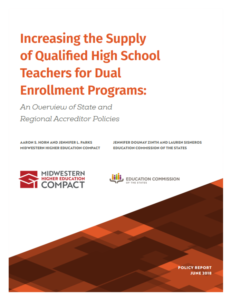 The report found that criteria for qualifying Career Technical Education (CTE) instructors are mentioned in state-level policies in eight states (Colorado, Illinois, Kansas, Maine, Missouri, Mississippi, Ohio, Virginia). Dual enrollment teacher qualification policies are generally related to education attainment level, but exemptions are sometimes made for CTE dual enrollment instructors. In some of these cases, states allow exemption from qualification rules when instructors can demonstrate proficiency in the field they will teach and consider industry recognized credentials and years of experience working in the field when determining teacher qualifications.
The report found that criteria for qualifying Career Technical Education (CTE) instructors are mentioned in state-level policies in eight states (Colorado, Illinois, Kansas, Maine, Missouri, Mississippi, Ohio, Virginia). Dual enrollment teacher qualification policies are generally related to education attainment level, but exemptions are sometimes made for CTE dual enrollment instructors. In some of these cases, states allow exemption from qualification rules when instructors can demonstrate proficiency in the field they will teach and consider industry recognized credentials and years of experience working in the field when determining teacher qualifications. A little over one year ago, Advance CTE launched
A little over one year ago, Advance CTE launched  Career exploration and guidance have in the past been considered as services only for CTE students, and particularly for CTE students who are not considering attending a postsecondary institution. Now state leaders are working to change this misconception by promoting career advisement as an integral part of the educational process for all learners.
Career exploration and guidance have in the past been considered as services only for CTE students, and particularly for CTE students who are not considering attending a postsecondary institution. Now state leaders are working to change this misconception by promoting career advisement as an integral part of the educational process for all learners. 
 In the nine months since President Obama signed the Every Student Succeeds Act (ESSA) into law last December, states and policymakers have been hard at work digging through the legislation and deciding how to structure their new plans. ESSA, which reauthorized the Elementary and Secondary Education Act, presents a number of opportunities to expand access to high-quality Career Technical Education (CTE). As states prepare to implement the law next year, we will provide periodic updates on their progress and share strategies for leveraging ESSA to support CTE at the state level.
In the nine months since President Obama signed the Every Student Succeeds Act (ESSA) into law last December, states and policymakers have been hard at work digging through the legislation and deciding how to structure their new plans. ESSA, which reauthorized the Elementary and Secondary Education Act, presents a number of opportunities to expand access to high-quality Career Technical Education (CTE). As states prepare to implement the law next year, we will provide periodic updates on their progress and share strategies for leveraging ESSA to support CTE at the state level.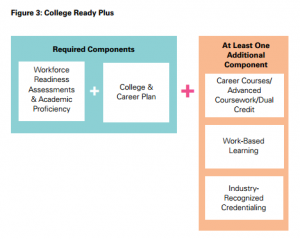 A
A 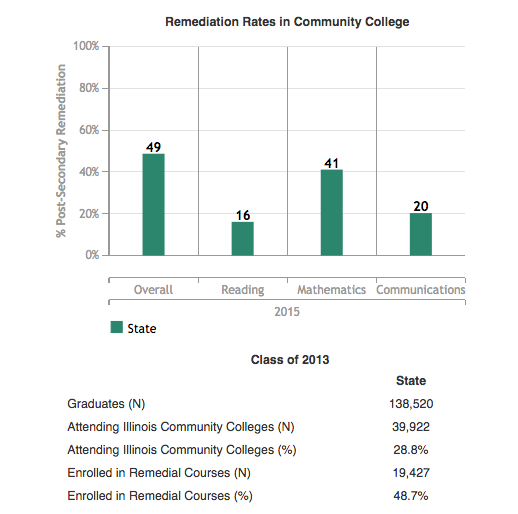 Last month Governor Bruce Rauner of Illinois
Last month Governor Bruce Rauner of Illinois  College is often considered a safe bet, but
College is often considered a safe bet, but  The report precedes an
The report precedes an 